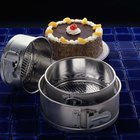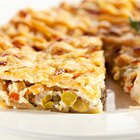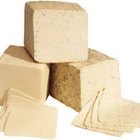Baked Sicilian ziti is a hearty Italian favorite that's both easy and versatile. Create a savory traditional version and serve it with a salad, or dress up the ziti with vegetables for a one-pot casserole dish. Use your favorite tomato sauce recipe or a prepared version and add the pasta and freshly grated cheese for a comforting baked entree that's destined to be a crowd-pleaser.
Preheat the oven to 400 degrees Fahrenheit.
Whip up a batch of your favorite pasta sauce recipe or set aside a room-temperature jar of a store-bought variety. Look for sauce ingredients traditional to Sicilian cooking, such as basil, bay leaves, cumin, marjoram oregano, savory, thyme and red pepper flakes.
Prepare the ziti to al dente texture according to package instructions, usually between 7 and 9 minutes. Drain the water off the pasta.
Mix together ricotta cheese and beaten egg in a small bowl. Stir in half of the mozzarella cheese and pecorino romano cheese.
Coat a baking pan with butter, oil or cooking spray.
Reserve 1/2 cup of sauce, then spread half of the remaining tomato sauce on the bottom of the dish in an even layer. Spread half the ziti on top of the sauce. Top with half of the cheese and egg mixture. Repeat the three layers, tomato followed by ziti and then cheese. Top with the reserved 1/2 cup of sauce and the reserved mozzarella and pecorino romano cheese.
Cover the baking dish with a lid or aluminum foil and bake for 25 to 30 minutes until hot through and the cheese is bubbling and lightly browned.
Related Articles

How to Make Lasagna With Sour Cream

How to Bake Mac & Cheese With a Bread ...

How to Make Fish Taco Sauce

How to Use Ricotta Cheese for Cream ...

How Long Can You Refrigerate Nacho ...

Easy Baked Ziti Recipe

How to Make Cottage Cheese Lasagna

How to Cook Fresh Sauerkraut and ...

Can I Make Baked Macaroni & Cheese With ...

How Many Calories in a Taco Bell Bean ...

How to Make Lasagna Pie in a Springform ...

Calories in Tahini Sauce

How to Cook With Green Fuzzy Squash

How to Make Baked Ziti

Easy Tuna Noodle Casserole Recipe

Fish & Pasta Meals

Add Flavor to Foods With This ...

How to Make Chicken Pot Pie With Puff ...

How to Cook With Havarti Cheese

How Do I Freeze Stuffed Shells?
References
Writer Bio
Bonnie Singleton has been writing professionally since 1996. She has written for various newspapers and magazines including "The Washington Times" and "Woman's World." She also wrote for the BBC-TV news magazine "From Washington" and worked for Discovery Channel online for more than a decade. Singleton holds a master's degree in musicology from Florida State University and is a member of the American Independent Writers.